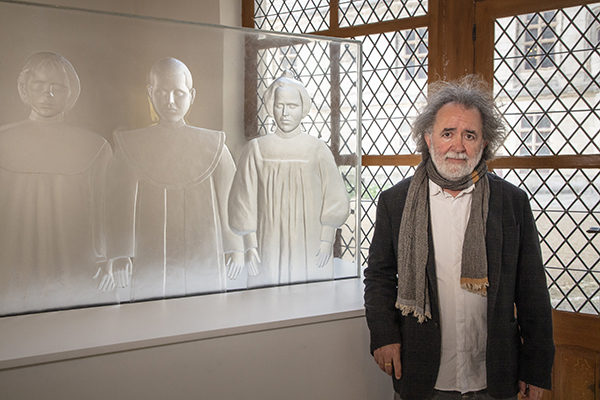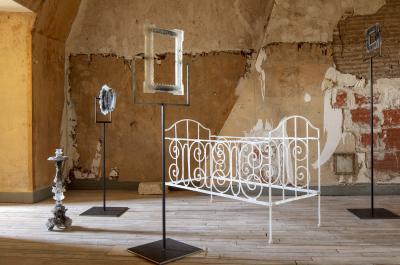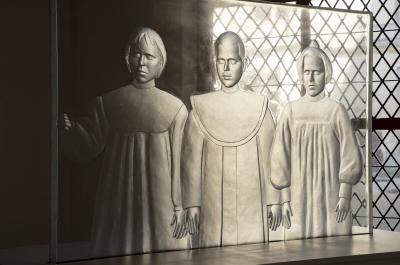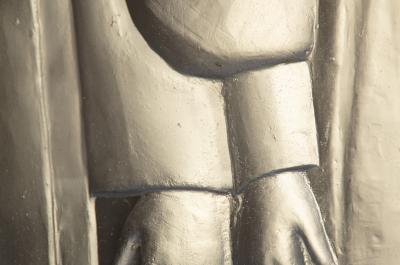A. Pascal Convert
"Chambre intérieure cristallisée" and "Les Trois anges"

Chambre intérieure cristallisée
LES TROIS ANGES
BIOGRAPHICAL NOTES

The son of an artist, Pascal Convert was born in 1957 in Mont-de-Marsan. He is a visual artist, writer and director, and defines his work as the archaeology of architecture, childhood, history, the body and time. He uses materials such as glass and wax to evoke the passage of time, light and the lasting effects of the past. In 1987, while he was living in Bordeaux, he covered the wooden panelling in one room of his apartment with plate glass, which formed the first in his series entitled Appartement de l’artiste. In 1989 and 1990 he was resident at the Villa Médicis in Rome, and in 1992 his first major solo exhibition was held at the CAPC (Contemporary Art Museum) in Bordeaux. In 1997 he was invited by the philosopher and art historian Georges Didi-Huberman to take part in the L’Empreinte exhibition at the Centre Pompidou alongside Giuseppe Penone, Man Ray, Alain Fleischer and others. Georges Didi-Huberman would go on to write several books about Convert’s work (published by Éditions de Minuit) and include him in numerous exhibitions. In 2002 he unveiled his memorial to resistance fighters and hostages, the Monument à la mémoire des résistants et otages fusillés au Mont Valérien entre 1941 et 1944 (Mémorial de la France combattante, Suresnes). Opposite the chapel where they were held before they were taken to the place of execution, Pascal Convert erected a 2.7m x 2.18m bronze bell engraved with the names of those who were killed. In 2003, as a continuation of this work, he made a documentary about the victims, Mont Valérien, aux noms des fusillés.
In 2007 his exhibition Lamento at Mudam in Luxembourg featured wax sculptures inspired by iconic press photos: La Pietà du Kosovo (1999-2000), based on a photo taken by Georges Mérillon, La Madone de Bentalha (2001-2002), based on a photo taken by Hocine Zaourar, and La Mort de Mohamed Al Dura (2002-2003), based on stills from a video by Talal Abou Rahmed. These sculptures have been widely exhibited at the United Nations, in Montreal, in Switzerland and in Italy. In the same year, he published a biography of Joseph Epstein, leader of the communist resistance in Paris, who was shot at Mont Valérien in 1944.
In 2008, he completed a set of stained glass windows for the abbey church of Saint Gildas des Bois (Loire-Atlantique). He then exhibited a huge crystal sculpture Le Temps scellé: Joseph Epstein et son fils, in the Force de l’Art exhibition at the Grand Palais in Paris in 2009. It is now part of the permanent collection of the Musée National d’Art Moderne in Paris. He again made a documentary film, Joseph Epstein: bon pour la légende. After four years of work, he published a new biography, Raymond Aubrac: résister, reconstruire, transmettre (Seuil, 2011), and made two documentary films about this leader of the French Resistance. Two years later the autobiographical story La Constellation du Lion (Grasset) was published. In 2014, he took part in the Busan Biennale in South Korea and the group exhibition La Guerre qui vient n’est pas la première: 1914-2014 at the Museum of Modern and Contemporary Art of Trento and Rovereto in Italy.
In 2016, he took part in the interdisciplinary exhibition, Soulèvements, at the Jeu de Paume arts centre. The highlight of that year was an invitation from the French ambassador to Afghanistan to commemorate the 15th anniversary of the destruction of the Buddhas of Bamiyan by the Taliban. Convert mounted an expedition in association with Iconem, an organisation that specialises in conflict zone archaeology. Using drones, he scanned the whole of the cliff face in Bamiyan to produce images that are now freely available to the global scientific community. Using a high-resolution camera, he made a “photographic impression” of the place where the monumental sculptures were carved about 1,600 years ago.
In 2019, the Éric Dupont Gallery dedicated a solo exhibition entitled Trois Arbres to his work. A piece with birch bark from Crematorium V at Auschwitz-Birkenau, a nuked cherry tree from Hiroshima, and the stone tree of life carvings found on Armenian khachkars.
Other projects are expected for 2021, with a dual exhibition in March of Panoramique de la falaise de Bamiyan, both at the Musée Guimet and the Louvre Lens, and in May the creation of an artwork for the Dôme des Invalides as part of the exhibition Napoléon? Encore. Encore. In the autumn, the Éric Dupont Gallery will hold a solo exhibition entitled Bibliothèque de Confinement, and there will be another project with the Cahn Contemporary Gallery in Basel.


